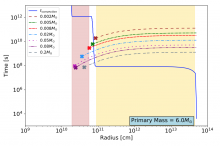
Abstract
A widely used method for parameterizing the outcomes of common envelopes (CEs) involves defining an ejection efficiency, $\abareff$, that represents the fraction of orbital energy used to unbind the envelope as the orbit decays. Given $\abareff$, a prediction for the post-CE orbital separation is possible with knowledge of the energy required to unbind the primary's envelope from its core. Unfortunately, placing observational constraints on $\abareff$ is challenging as it requires knowledge of the primary's structure at the onset of the common envelope phase. Numerical simulations have also had difficulties reproducing post-CE orbital configurations as they leave extended, but still bound, envelopes. Using detailed stellar interior profiles, we calculate $\abareff$ values for a matrix of primary-companion mass pairs when the primary is at maximal extent in its evolution. We find that the ejection efficiency is most sensitive to the properties of the surface-contact convective region (SCCR). In this region, the convective transport timescales are often short compared to orbital decay timescales, thereby allowing the star to effectively radiate orbital energy and thus lower $\abareff$. The inclusion of convection in numerical simulations of CEs may aid ejection without the need for additional energy sources as the orbit must shrink substantially further before the requisite energy can be tapped to drive ejection. Additionally, convection leads to predicted post-CE orbital periods of less than a day in many cases, an observational result that has been difficult to reproduce in population studies where $\abareff$ is taken to be constant. Finally, we provide a simple method to calculate $\abareff$ if the properties of the SCCR are known.